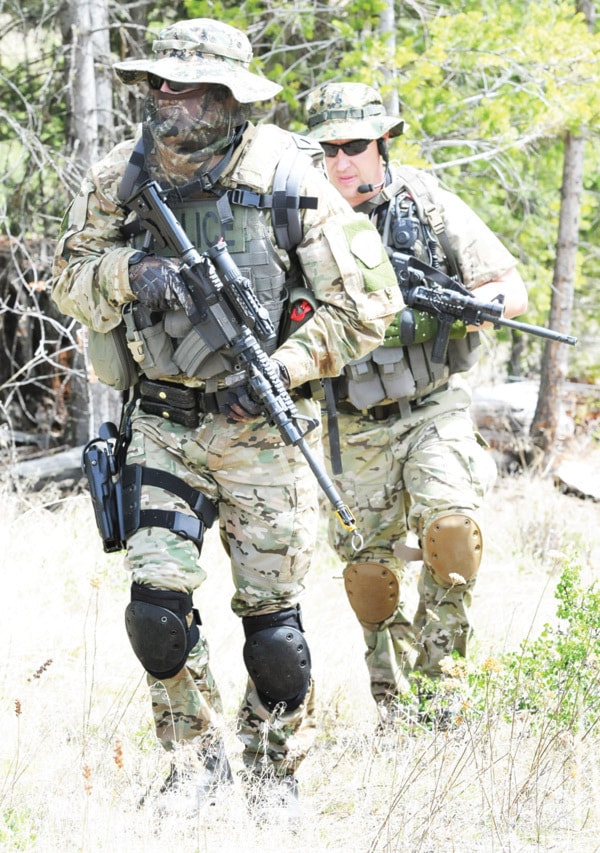Getting inside the erratic mind of a potential killer with innocent victims at his disposal is not an easy task — something Cpl. Brenda Daly knows all too well.
For the past 12 years in her role as the RCMP’s hostage negotiator she has been involved in some extremely volatile situations.
“Each one is different and every person you deal with is different, so what we try to do is get as much information as we can before we make contact,” said Daly, who works out the Kelowna detachment and is the current leader for the southeast negotiating team. “These people are often in a very stressed state because of the situation, so we try and calm them down and usually everything is very fluid, but especially with a hostage, we want to get them out as soon as possible.”
That was particularly true in one of her most recent cases in which she had to deal with a man who walked into a bank in Chase armed with a bomb, gun and knife.
After a five-hour standoff, the suspect gave up to ERT members waiting outside the building.
And the corporal’s negotiating skills were once again called to task earlier this week when over 30 members of the Southeast ERT team converged on a small cabin in the forested area around Agur Lake just west of Summerland.
The difference this time was the hostage incident was just a simulation — part of the required training for those units called out in the most extreme situations.
In those cases, the triangle approach is used, with the incident command at the top and the tactical (armed) and negotiating teams at either point below.
Although the participants have regular duties at other detachments, each has specialized and ongoing training for their specific role.
“The skill set that these members have, it’s unique in the RCMP and it’s one that they test here today in this scenario,” said Cpl. Brian Burke of the Penticton RCMP, the training co-ordinator for the program. “Unlike what you see on TV, the goal in any actual call-out or training environment is to have a peaceful resolution. However, we do have options available to us that if it escalates and we have to use any level of force, we need to take someone into custody or save somebody’s life, then we have those resources.”
 The fact this event was only an exercise did not lessen the efforts or seriousness in which the matter was treated by those taking part.
The fact this event was only an exercise did not lessen the efforts or seriousness in which the matter was treated by those taking part.
As the large mobile command and communications unit where Daly would work was set up, camouflaged members armed with submachine guns stealthily made their way through the forest to set up a perimeter around the building.
While some responders like Kamloops members Const. Patrick Ellis and Cpl. Chris Bannerholt were deployed by the police helicopter, others were moved to the region by ground transportation.
This particular exercise was under the direction of incident commander Staff Sgt. Kevon Sellers of Kelowna.
“With what we’re doing here, it is not necessarily the end result we’re looking at, but making sure we have all the right pieces and the right people knowing what their roles are,” he said. “This is a rural scenario, but it could be any type of situation — a bank robbery — so we have to be able to adapt this to any situation.”
Burke noted through past experience, police have found the team approach to such emergencies is much more successful in achieving a positive result.
“Over time and space we’ve learned one person can’t do it all, you have a group who work well together,” he said. “What I look for in members who get involved in these types of situations are people with a proven track record, you want people who are team players.
“I’ve said it numerous times and I can’t stress it enough, (the goal) is to have a peaceful resolution and at the end of the day everyone goes home safe.”
Following the completion of the activities at the site, most of those taking part had an opportunity to sit down to a de-briefing session where their actions were analyzed.
“We all have to get on the same page, and at the end of the day we have to find out what worked and what didn’t,” said Burke.
According to Sellers, even more difficult than the staging of the exercise is the logistics to make it possible in the first place, one of those simply being a location.
He and Burke both expressed their appreciation to the directors of the Agur Lake Camp Society for their willingness to allow the utilization of their facilities by the RCMP for the exercise.

